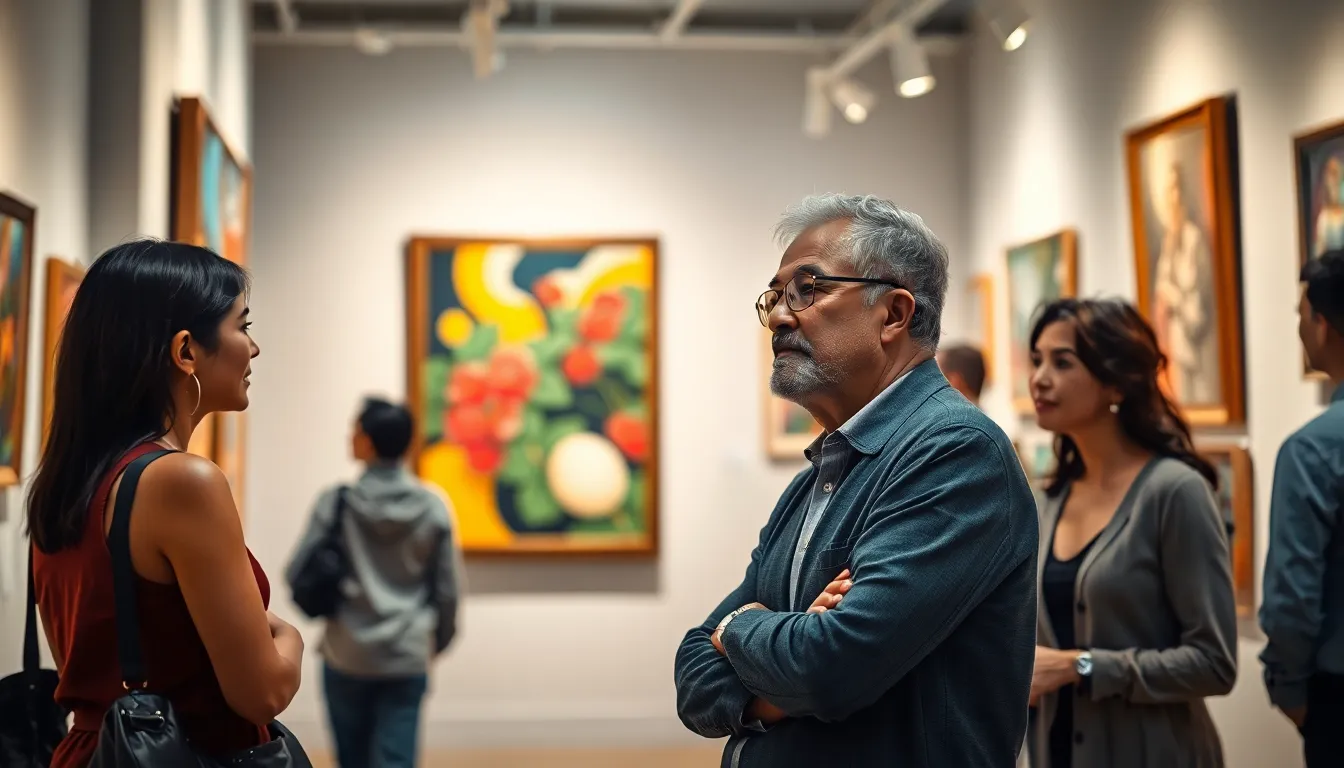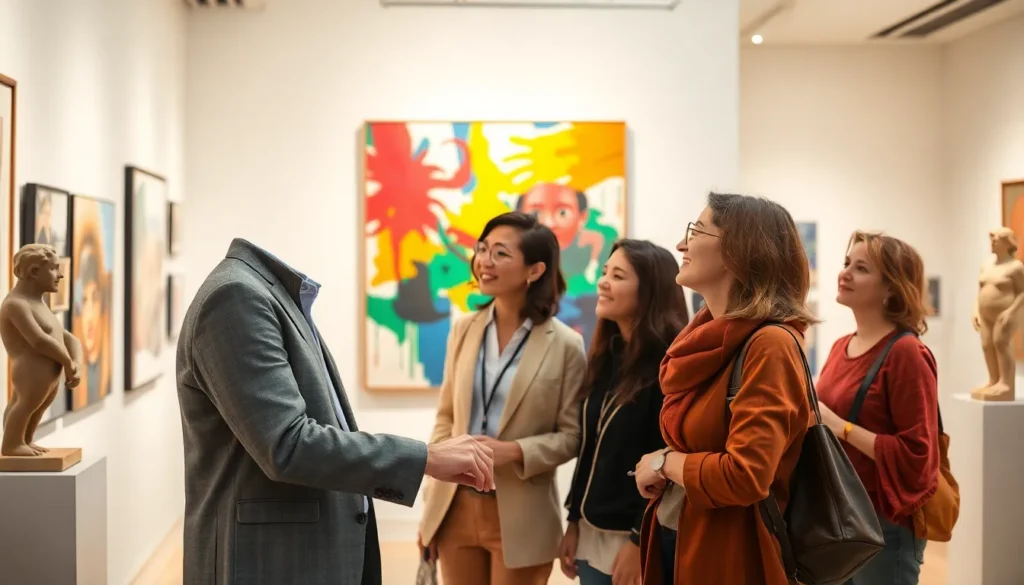Investing in art isn’t just for the elite with monocles and top hats; it’s for anyone looking to add a splash of color to their portfolio. Picture this: while stocks fluctuate like a caffeinated squirrel, art can appreciate quietly on your wall, adding beauty and value to your life. Who wouldn’t want to own a piece of history or a conversation starter that makes guests think you’re a sophisticated connoisseur?
But let’s face it, diving into the art world can feel like stepping into a gallery filled with abstract paintings—confusing and a little intimidating. Fear not! With the right approach, anyone can navigate this vibrant landscape and discover treasures that not only please the eye but also promise potential returns. So grab your beret and let’s explore how investing in art can be both a savvy financial move and a delightful journey into creativity.
Table of Contents
ToggleUnderstanding Art Investment
Art investment is a growing option for diverse investors. It offers both aesthetic enjoyment and potential financial returns.
What Is Art Investment?
Art investment involves purchasing artworks with the expectation that their value will increase over time. Investors seek undiscovered talent or established artists to diversify their portfolios. Investing in art requires knowledge of market trends and valuation methods. The overall goal is to navigate the art market effectively for financial gain and personal appreciation.
Types of Art to Invest In
Various art forms appeal to investors, each with unique characteristics. Traditional paintings often attract significant attention, particularly from renowned artists. Sculptures represent another valuable category, blending artistic creativity with physical presence. Photography has gained popularity as a contemporary investment space, offering different styles and artists. Emerging art forms, such as digital art and NFTs, present innovative opportunities for forward-thinking investors. Collectors often benefit from diversifying across these categories to mitigate risks and maximize returns.
The Benefits of Investing in Art

Investing in art offers numerous advantages that appeal to both financial and personal interests. Investors often find this market rewarding and unique due to its distinctive characteristics.
Potential for High Returns
Art has demonstrated potential for significant appreciation over time. Historical data indicates that well-chosen pieces can exceed traditional investments like stocks and bonds. Investors benefit from diversifying their portfolios with artworks by established or emerging artists. Market trends show that certain artworks appreciate substantially during economic upswings. A thorough understanding of the art market aids in selecting pieces with strong potential for value increase. Therefore, engaging with auctions and galleries enhances opportunities for acquiring valuable investments.
Enjoyment and Aesthetic Value
Beyond financial returns, art provides intrinsic enjoyment and aesthetic value. Collectors surround themselves with creations that spark joy and inspire conversations. Unique pieces can enhance interior spaces and contribute to personal expression. Art appreciation often leads to a deeper connection with culture and creativity. Additionally, showcasing art can elevate the ambiance of homes and offices, making environments more inviting. Investing in art encourages the exploration of varying artistic styles and mediums. Finding beautiful works to enjoy fosters a fulfilling experience beyond mere investment returns.
Risks Involved in Art Investment
Investing in art carries several risks that potential collectors should understand. Awareness of these risks contributes to making informed decisions in the art market.
Market Fluctuations
Market fluctuations can significantly impact art values. Economic downturns often lead to decreased demand, which may drop prices. Cultural trends also shift, affecting the desirability of specific art pieces. Art investments might not yield stable returns, unlike stocks or bonds. The importance of research on current trends can’t be overstated. Investors should analyze previous performance data and observe auction results to understand market dynamics better. Engaging with art advisors might provide additional insights into emerging artists or significant movements, thereby mitigating risks.
Authenticity and Provenance Concerns
Authenticity and provenance concerns pose considerable risks in art investment. Verifying a piece’s authenticity can sometimes be challenging, leading to the potential for purchasing fakes. Collectors must seek reliable sources and documentation to establish provenance, which is crucial in verifying a work’s history and value. The absence of thorough documentation might raise red flags for investors. Ensuring that artworks come from reputable galleries or established auction houses can help minimize these risks. Additionally, expert appraisal may provide reassurance regarding authenticity, enabling collectors to make more confident purchases.
How to Get Started with Investing in Art
Entering the art investment landscape begins with proper preparation and knowledge.
Researching the Art Market
Understanding the art market is crucial for informed investing. Collectors should study market trends and valuation methods. Historical data can reveal which artists or styles appreciate more consistently. Online resources like auction house reports and art market analysis platforms provide valuable insights. Engaging with art forums and community groups also enhances market knowledge. Tracking sales and exhibitions at galleries offers real-time information about emerging artists and popular works. Lastly, attending art fairs can foster direct connections with sellers, enriching the overall understanding of current market dynamics.
Finding Reputable Art Advisors
Identifying trustworthy art advisors significantly simplifies the investment process. Experienced advisors possess extensive market knowledge and contacts within the art community. Look for professionals with credentials from recognized institutions or significant experience in art consultation. Searching for online reviews helps gauge advisors’ reputations. Personal recommendations from fellow collectors or institutions also prove beneficial. Confirm that chosen advisors align with the collector’s artistic interests and investment goals. Lastly, transparent communication regarding fees and services fosters trust and ensures a productive partnership.
Investing in art offers a unique blend of financial potential and personal enjoyment. As more individuals recognize its accessibility, the art market continues to evolve, inviting diverse investors to participate. With careful research and an understanding of market dynamics, collectors can uncover valuable pieces that not only enhance their portfolios but also enrich their lives.
Navigating the complexities of art investment may seem challenging, but the rewards can be significant. By leveraging expert advice and engaging with reputable sources, collectors can mitigate risks while embracing the beauty and creativity that art brings. Ultimately, investing in art is not just a financial decision; it’s an opportunity to connect with culture and express individuality.













